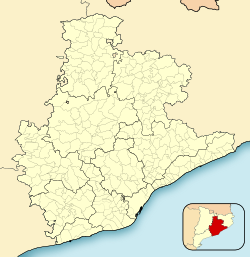Carme, Barcelona
| Carme | ||
|---|---|---|
| Municipality | ||

Sant Martí church square
|
||
|
||
| Location in Catalonia | ||
| Coordinates: 41°32′0″N 1°37′18″E / 41.53333°N 1.62167°ECoordinates: 41°32′0″N 1°37′18″E / 41.53333°N 1.62167°E | ||
| Country |
|
|
| Community |
|
|
| Province |
|
|
| Comarca | Anoia | |
| Government | ||
| • Mayor | Jordi Sellarès Poch (2015) | |
| Area | ||
| • Total | 11.7 km2 (4.5 sq mi) | |
| Population (2014) | ||
| • Total | 817 | |
| • Density | 70/km2 (180/sq mi) | |
| Website | www |
|
Carme is a municipality in the comarca of the Anoia in Catalonia, Spain. Specifically, the town is in the middle of a valley, which is composed of a band of the range Orpinell (751 m.) and the other by the Collbàs (544 m.). The village is anchored to the bottom of the valley, in the woods and subtle section of large populations. The capital of the region of Anoia, Igualada, is just ten kilometers from the village, while other municipalities La Pobla de Claramunt or Capellades are barely about five kilometers from the village. Currently the village has approximately 800 inhabitants, but in holiday seasons this figure may be slightly increased.
The village has all the basic services fully independently (pharmacy, grocery store, restaurants, swimming pool, kiosk, rural accommodation, bakery or medical services) and permanent, which avoids long journeys when carrying daily activities. But as we have already mentioned beforehand, the capital of the region is barely ten minutes drive, allowing fluid communication with all services, whether available local, state or national. Otherwise the capital, Barcelona, is located just one hour from the village, is a particular way by car or public transport.
However the look and the space in which is the town of Carmen are completely different from that presented in the Catalan capital. As we said Carmen is in the middle of a valley, forest, terraces and gardens are what really brings the essence rural town. Carmen has managed to adapt to modernity and new technologies without losing its essence and traditions.
Historically the town can place it at the end of the Middle Ages, although the first historical documents of the town speak of the late seventeenth century. At the time of the Arab conquest and during the same average age (s. X-XV), much of Catalonia, or what is the same, then the Aragonese crown was partially occupied by Muslims. This caused the middle of the country formed a series of fortifications in order to monitor the progress of Muslims to Europe today. This set of fortifications known as the border castles, and correspond to a fictitious line drawn through the current central Catalonia allowing visually dominate a vast territory and defend it quickly and efficiently. Some castles then be visited on route "border castles of the Middle Ages" along the Catalan territory. In fact, the Anoia region is one of the most preserved castles and small fortresses, and allows for a very similar to the reality of that time. One of the best preserved and restored castles is the La Pobla de Claramunt, located five kilometers from the town of Carmen and you can enjoy medieval art in a quiet and without car. Some of these other castles and fortresses are Orpí of the Calaf, mirrors, etc.
...
Wikipedia



